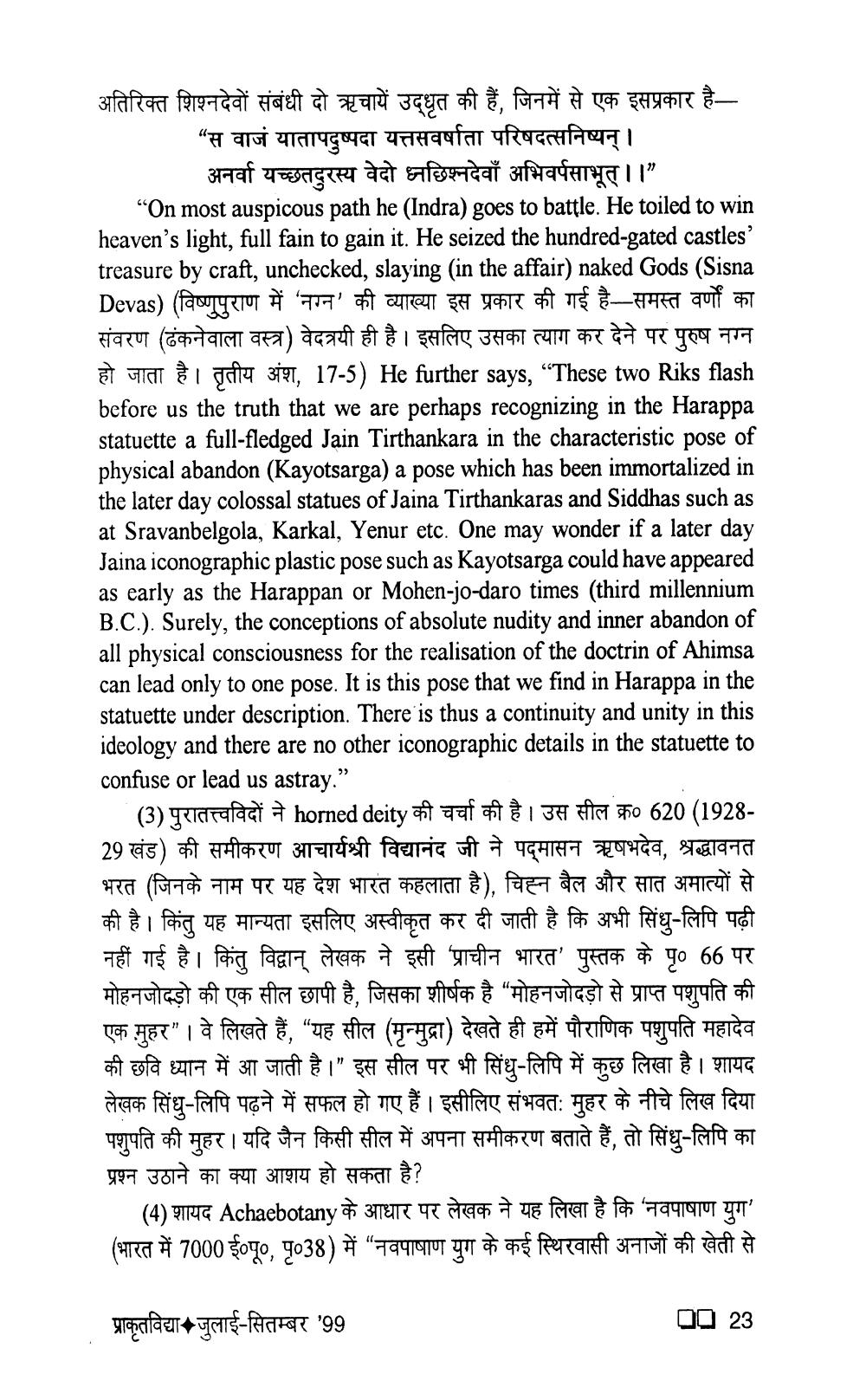________________
अतिरिक्त शिश्नदेवों संबंधी दो ऋचायें उद्धृत की हैं, जिनमें से एक इसप्रकार है“स वाजं यातापदुष्पदा यत्तसवर्षाता परिषदत्सनिष्यन् ।
अनर्वा यच्छतदुरस्य वेदो ध्नछिश्नदेवाँ अभिवर्पसाभूत् । । "
“On most auspicous path he (Indra) goes to battle. He toiled to win heaven's light, full fain to gain it. He seized the hundred-gated castles' treasure by craft, unchecked, slaying (in the affair ) naked Gods (Sisna Devas) (विष्णुपुराण में 'नग्न' की व्याख्या इस प्रकार की गई है - समस्त वर्णों का संवरण (ढंकनेवाला वस्त्र) वेदत्रयी ही है। इसलिए उसका त्याग कर देने पर पुरुष नग्न हो जाता है। तृतीय अंश, 17-5) He further says, “These two Riks flash before us the truth that we are perhaps recognizing in the Harappa statuette a full-fledged Jain Tirthankara in the characteristic pose of physical abandon (Kayotsarga) a pose which has been immortalized in the later day colossal statues of Jaina Tirthankaras and Siddhas such as at Sravanbelgola, Karkal, Yenur etc. One may wonder if a later day Jaina iconographic plastic pose such as Kayotsarga could have appeared as early as the Harappan or Mohen-jo-daro times (third millennium B.C.). Surely, the conceptions of absolute nudity and inner abandon of all physical consciousness for the realisation of the doctrin of Ahimsa can lead only to one pose. It is this pose that we find in Harappa in the statuette under description. There is thus a continuity and unity in this ideology and there are no other iconographic details in the statuette to confuse or lead us astray."
(3) पुरातत्त्वविदों ने horned deity की चर्चा की है। उस सील क्र० 620 (192829 खंड) की समीकरण आचार्यश्री विद्यानंद जी ने पद्मासन ऋषभदेव, श्रद्धावनत भरत (जिनके नाम पर यह देश भारत कहलाता है), चिह्न बैल और सात अमात्यों से की है। किंतु यह मान्यता इसलिए अस्वीकृत कर दी जाती है कि अभी सिंधु-लिपि पढ़ी नहीं गई है। किंतु विद्वान् लेखक ने इसी 'प्राचीन भारत' पुस्तक के पृ० 66 पर मोहनजोदड़ो की एक सील छापी है, जिसका शीर्षक है " मोहनजोदड़ो से प्राप्त पशुपति की एक मुहर" । वे लिखते हैं, “यह सील (मृन्मुद्रा) देखते ही हमें पौराणिक पशुपति महादेव की छवि ध्यान में आ जाती है ।" इस सील पर भी सिंधु - लिपि में कुछ लिखा है। शायद लेखक सिंधु-लिपि पढ़ने में सफल हो गए हैं। इसीलिए संभवतः मुहर के नीचे लिख दिया पशुपति की मुहर । यदि जैन किसी सील में अपना समीकरण बताते हैं, तो सिंधु-लिपि का प्रश्न उठाने का क्या आशय हो सकता है ?
(4) शायद Achaebotany के आधार पर लेखक ने यह लिखा है कि 'नवपाषाण युग' (भारत में 7000 ई०पू०, पृ038 ) में "नवपाषाण युग के कई स्थिरवासी अनाजों की खेती से
प्राकृतविद्या जुलाई-सितम्बर 199
10 23




